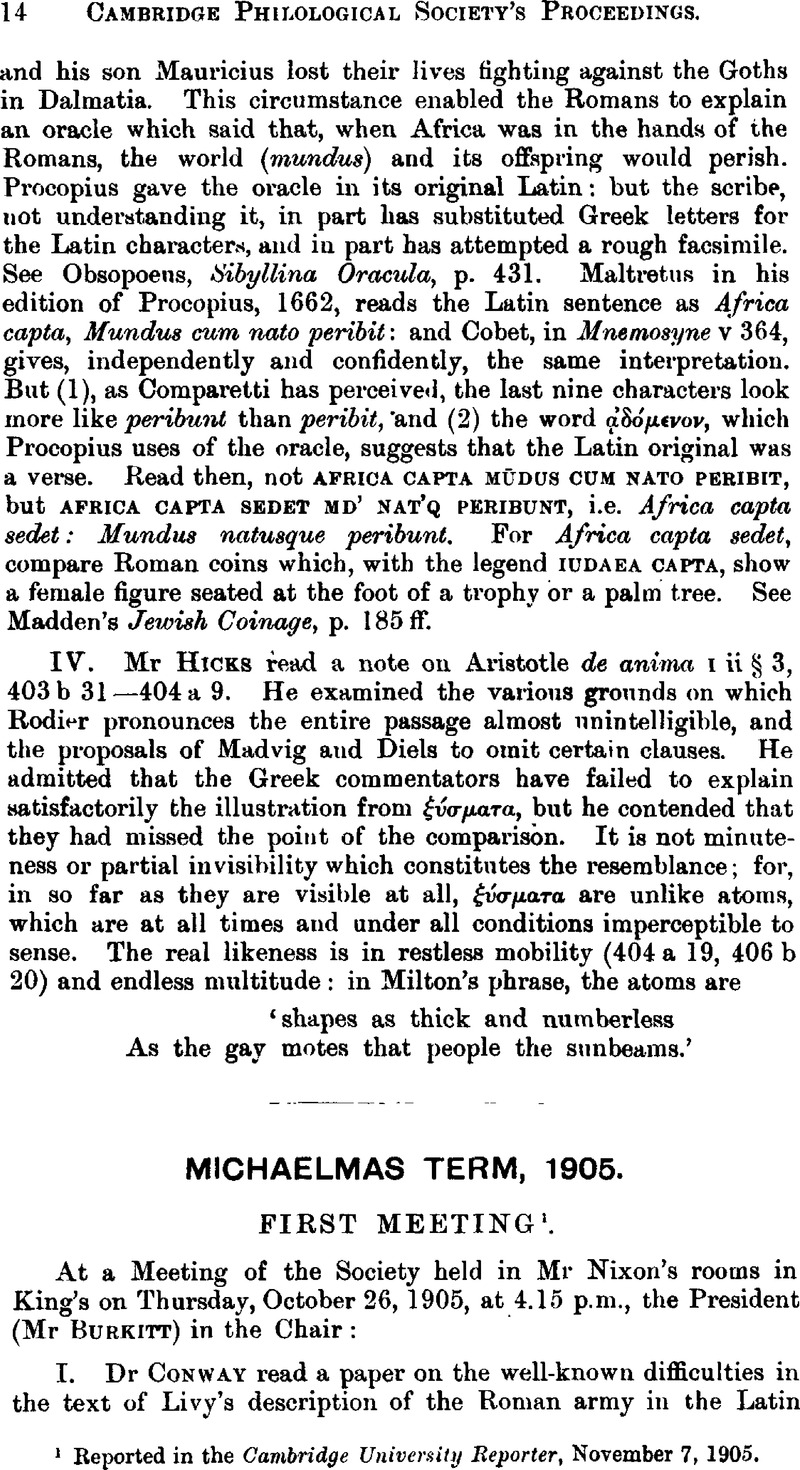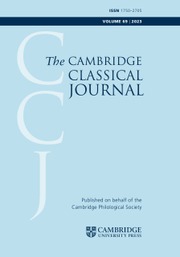No CrossRef data available.
Article contents
Abstract

- Type
- Michaelmas Term, 1905
- Information
- Copyright
- Copyright © The Author(s). Published online by Cambridge University Press 1905
References
page 15 note 1 A question which had then been unanswered Dr Conway had now determined by looking through the Althorp collection of Editions of Livy in the Rylands Library; namely that the division into chapters was first made by Gruter (see the preface to his Frankfurt edition of 1628, published after his death).
page 15 note 2 Such a degree of faithfulness in M did not seem yet to have been recognised, but it was often important. Thus in 5. 16. 6 M reads rightly et receptis, but P ex receptis (corr. P2). Now here in M the t has an unusually long final stroke, rising through the head of the r (tre), and it was this sign in some earlier codex which was mistaken by the scribe of P; it is of course well-known that P and M are entirely independent of one another. Other examples of peculiarities in letters faithfully copied in M but giving rise to corruptions elsewhere (or mis-read by modern editors) were: 5. 18. 6 (declaratus M, -ata P); 5. 21. 2 (delendam M, dol- P); 5. 43. 1 (facere M, -eret P); 4. 17. 4 (elusus M, clusus P); 4. 26. 7 M appears to have terribiliosa, but the s is merely the scribe's faithful rendering of a 9th century r with a high curl (Γ). In 5. 34. 9 M reads Haduorum for Haeduorum but the a has a heavy point after it (a·), and is merely the scribe's rendering of a faint or careless ae (![]() ). All the five examples just cited from Book v are in Tertius' work.
). All the five examples just cited from Book v are in Tertius' work.
Mr Burkitt adds a parallel case:
[The stemma codicum in the Liber Regularum of Tyconius (Texts and Studies III i, ed. Burkitt, ) isGoogle Scholar

The relations are quite clear. Thus R and V are independent authorities, while G, P and O are descendants of V itself. V has been much corrected, apparently at various times; sometimes G (and P) follow V*, more often Vcorr.
In p. 6, line 26 of my edition, we find ostenderat. This is in R and V, but in V it is written oftender∝t, the form ∝ for “A” not being noted elsewhere. The cast of the sentence renders “ostenderet” plausible, so we find in P (not oftenderat or oftenderet) but oftenderæ.
i.e. oatenderæt [? a barbarous spelling of ostenderet]. In any case æ looked to me like an imitation of the ∝t of V, which (though a correct way of writing “at”) is uncommon in this particular MS. F. C. B.]
page 15 note 3 Two of these old marginalia were of special interest as proving directly what had been inferred from textual considerations in Dr Conway's previous paper. In a summary of 9. 3 init. which appears in the margin of Quatern. 23 p. 6, col. i the name of the Caudine Forks is spelt Pfurculas Caudinas, where the pf- was a mistake only possible to a German writer. The hand and ink of this gloss were in every respect the same as that of the text of the body of the page, and were therefore copied in along with the text. And in a comment on 5. 44. 4, where Camillus describes the weakness of the Gauls, the margin has qualis erat forma gallorum, huiuscemodi est alamannorum, which suggested that Prof. Ridgeway's view of the similarity of Gauls and Germans was not unknown in the 9th century, and at all events, showed that M's exemplar contained notes from some one familiar with ‘Alamanni.’ This evidence demonstrated that at some stage the text of M was drawn at least in part from a Northern codex.
page 16 note 1 Livius, Madvig and Ussing, Ed. 3 Praef.




